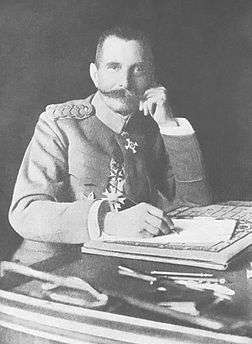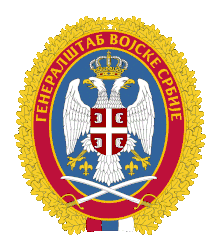Petar Bojović
Petar Bojović GCLH, KCMG (Serbian: Петар Бојовић, pronounced [pětar bǒːjoʋitɕ]; 16 July 1858 – 19 January 1945) was a Serbian military commander who fought in the Serbo-Turkish War, the Serbo-Bulgarian War, the First Balkan War, the Second Balkan War, World War I and World War II. Following the breakthrough on the Thessaloniki Front he was promoted to fourth Field Marshal.
Petar Bojović GCLH, KCMG | |
|---|---|
 | |
| Deputy Commander in Chief of the Royal Yugoslav Armed Forces | |
| In office 3 April 1941 – 17 April 1941 | |
| Monarch | Peter II |
| Preceded by | Prince Paul |
| Succeeded by | Dušan Simović |
| Chief of the General Staff of the Royal Yugoslav Armed Forces | |
| In office 21 January 1921 – 8 December 1921 | |
| Monarch | Peter I Alexander I |
| Preceded by | Živojin Mišić |
| Succeeded by | Petar Pešić |
| Chief of Staff of the Supreme Command of the Serbian Army | |
| In office 8 December 1915 – 1 July 1918 | |
| Monarch | Peter I |
| Preceded by | Radomir Putnik |
| Succeeded by | Živojin Mišić |
| Chief of the Serbian General Staff | |
| In office 1906–1908 | |
| Monarch | Peter I |
| Preceded by | Aleksandar Mašin |
| Succeeded by | Radomir Putnik |
| Personal details | |
| Born | 16 June 1858 Miševići, Nova Varoš, Ottoman Empire |
| Died | 19 January 1945 (aged 86) Belgrade, Kingdom of Yugoslavia |
| Resting place | Belgrade New Cemetery |
| Spouse(s) | Mileva Bojović (1893–1945; his death) |
| Children | Božidar Bojović Vojislav Bojović Jelica Bojović Dobrosav Bojović Rada Bojović Radoslav Bojović |
| Alma mater | Military Academy Serbia |
| Profession | Army officer |
| Awards | |
| Military service | |
| Allegiance | |
| Branch/service | Serbian Army |
| Years of service | 1876–1921 1941 |
| Rank | Field Marshal |
| Commands | Serbian 1st Army |
| Battles/wars | Serbo-Turkish War Serbo-Bulgarian War First Balkan War Second Balkan War World War I World War II |
Life
Early life
Bojović was born on 16 July 1858 in Miševići, Nova Varoš. He had distant ancestry from the Vasojevići.
He fought in Serbian-Ottoman Wars from 1876 to 1878 as a cadet of the Artillery school, as well as in wars that Serbia waged at the beginning of the 20th century.[1] He was Chief of the General Staff for the first time from 1905 to 1908.
Balkan Wars
In the Balkan Wars, he was the Chief of Staff of the 1st Army, which scored huge success in battles of Kumanovo, Bitola (First Balkan War) and Bregalnica (Second Balkan War). Given that the commander was the militarily infinitely less experienced crown prince Alexander who had to rely heavily on his chief of staff - the appointment made him effectively the commander of the army. He took part in peace negotiations with Turkey, held in London in 1913, as a military expert in the Serbian Government delegation.
World War I
At the start of World War I, he was given command of the 1st Army. His army suffered huge losses at the Battle of Drina in 1914, but managed to stop the Austro-Hungarian offensive. Bojović was wounded in the battle, and was replaced at the army general position by Živojin Mišić. In January 1916, he was appointed Chief of General Staff for a second time in place of the ailing vojvoda Radomir Putnik, who was carried by his soldiers to the city of Skadar. He held that position until June 1918, when he resigned because of disputes with the allied generals on the issue of widening the Thessaloniki Front. He returned to his position Commander of the 1st Army, which broke the enemy lines and advanced deep into the occupied territory. He received the title of Field Marshal on 26 September [O.S. 13 September] 1918 for his contribution during the war.[1]
Inter-war years and World War II
In 1921, he was appointed Chief of the General Staff of the Yugoslav Army, and in 1922 he withdrew from active service.
At the very beginning of World War II, Petar Bojovic was appointed Deputy Commander-in-Chief of the Yugoslavian Armed Forces by the young King Petar II Karađorđević. However, because of his old age, he did not participate in the events that followed.
Death
Petar Bojović was beaten on 19 January 1945 by a group of Partisans who came to forcibly evict him from his home in Trnska street in Belgrade.[1] According to an alleged testimony:[2]
Broz 'liberators' entered the house of the Bojović in Trnska street No. 25. They liked the house. Once inside, the noticeable Voivod robe was over a chair, and on the table lay the Voivod hat. The very fact that Bojović was 'King's Voivoda' was enough for the 'liberators' to use force. First, kicking his voivoda hat, and then, after harsh words, they rushed to the weak Bojović, at that time at his ninth decade of life. Petar's son Dobrosav jumped to protect his father, but was overcome by a strong shock, and soon after that he was sent to the penitentiary Sremska Mitrovica.
Bojović soon died of the injuries sustained. His body was transferred to the Belgrade New Cemetery in a wagon on 20 January 1945 and the burial was held privately.[1]
To prevent his being paid tribute, the Communists on Radio Belgrade announced that anyone who tried to come to Bojović's funeral would be arrested and prosecuted.[3]
The new Administration in 1945 named one of the important streets in Belgrade after Vojvoda Bojović.[4] It is a street previously called Donjogradski bulevar, which is today called Bulevar vojvode Bojovića. In 1990 a monument to Bojović was erected in the small park in the Kalenić neighborhood.[1] The park, which is encircled by the small roundabout, became known as the "Park of Vojvoda Bojović".
Awards and decorations
| Serbian military decorations[5] | |
| Order of the Karađorđe's Star, Grand Officer | |
| Order of the Karađorđe's Star, Commander | |
| Order of the Karađorđe's Star, Knight | |
| Order of the Karađorđe's Star with Swords, Grand Officer | |
| Order of the Karađorđe's Star with Swords, Commander | |
| Order of the Karađorđe's Star with Swords, Officer | |
| Order of the White Eagle, Commander | |
| Order of the White Eagle, Officer | |
| Order of the White Eagle, Knight | |
| Order of the White Eagle with swords, Grand Officer | |
| Order of the White Eagle with swords, Knight | |
| Order of St. Sava, Commander | |
| Order of the Cross of Takovo, Grand Officer | |
| Order of the Cross of Takovo, Commander | |
| Order of the Cross of Takovo, Officer | |
| Order of the Cross of Takovo, Knight | |
| Order of the Yugoslav Crown, Grand Officer | |
| Serbian Service Medals | |
| Medal for Bravery | |
| Commemorative medal of the King Petar I | |
| Commemorative medal of the wars with Turkey 1876-1878 | |
| Commemorative medal of the war with Bulgaria 1885 | |
| Commemorative Medal of the First Balkan War | |
| Commemorative Medal of the Second Balkan War | |
| Commemorative Medal of the First World War | |
| Commemorative Medal of the Albanian Campaign | |
| International and Foreign Awards | |
| Order of St Michael and St George, Knight Commande (United Kingdom) | |
| Order of St Michael and St George, Companion (United Kingdom) | |
| Order of Franz Joseph, Knight (Austria-Hungary) | |
| Legion of Honour, Grand Officer (France) | |
| Legion of Honour, Commandeur (France) | |
| Legion of Honour, Officer (France) | |
| Legion of Honour, Chevalier (France) | |
| War Cross 1914–1918, Bronze palm (France) | |
| Order of the Redeemer, Grand Commander (Greece) | |
| Order of the Redeemer, Gold Cross (Greece) | |
| Order of Saint Alexander (Bulgaria), II class (Kingdom of Bulgaria) | |
| Order of Military Merit, II class (Bulgaria) | |
| Order of Civil Merit, II class (Bulgaria) | |
| Order of Saints Maurice and Lazarus, Knight Grand Cross (Italy) | |
| Order of the Dannebrog, Knight (Kingdom of Denmark) | |
| Order of Saint Vladimir), III class (Russian Empire) | |
| Order of St. George with swords, III class (Russian Empire) | |
References
- Nikola Belić (October 31, 2012), "Dan sećanja na zaboravljeno oslobođenje Beograda" [Day of remembrance on the forgotten liberation of Belgrade], Politika (in Serbian)
- "NAŠA POSLA: Slavimo one koji su pre 50 godina šutirali do smrti srpske heroje!". www.telegraf.rs.
- "Славимо оне који су пре 50 година шутирали до смрти српске хероје! - СРБИН.ИНФО". srbin.info.
- Leko 2006, pp. 165,168.
- "Деда Коста сачувао војводинo ордење". www.novosti.rs (in Serbian). Retrieved February 15, 2020.
Literature
- DiNardo, Richard L. (2015). Invasion: The Conquest of Serbia, 1915. Santa Barbara: Praeger.CS1 maint: ref=harv (link)
- Leko, Milan; Vartabedijan, Miodrag (2006). Beogradske ulice i trgovi 1872-2006. Beograd: Zavod za udžbenike.
| Wikimedia Commons has media related to Petar Bojović. |
| Military offices | ||
|---|---|---|
| Preceded by Radomir Putnik |
Chief of the General Staff (acting) 1915–1916 |
Succeeded by Continued service |
| Preceded by Himself |
Chief of the General Staff 1916–1918 |
Succeeded by Živojin Mišić |
| Preceded by Živojin Mišić |
Chief of the General Staff of the Army of The Kingdom of Serbs, Croats and Slovenes 1921 |
Succeeded by Petar Pešić |
| Preceded by Prince Paul |
Deputy Commander in Chief of the Yugoslavian Armed Forces 1941 |
Succeeded by Dušan Simović |
